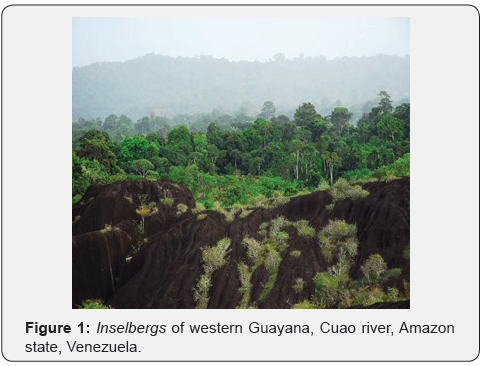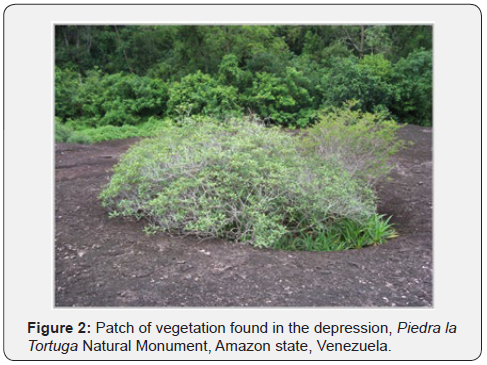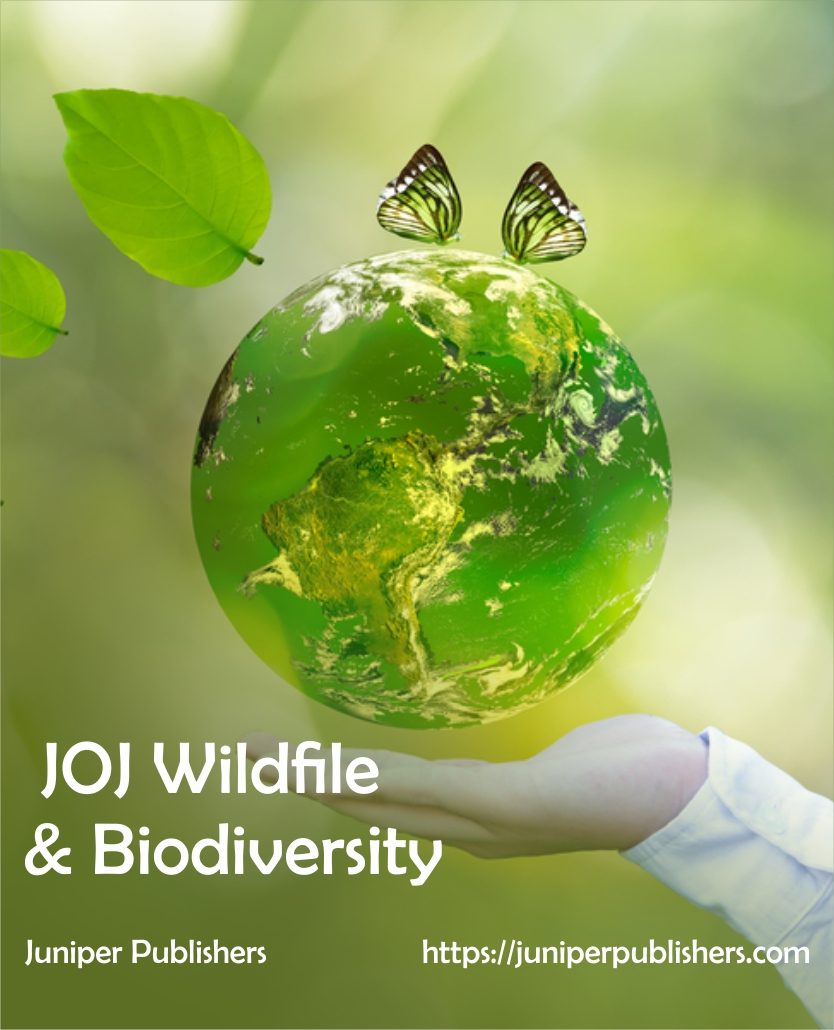inselbergs of Venezuelan Guayana Region: A Natural Laboratory for Plant Ecology Research
Pedro Manuel Villa*
Program in Botany, Federal University of Viçosa, Brazil
Submission: January 17, 2019; Published: May 28, 2019
*Corresponding author: Pedro Villa, Researcher, Program in Botany, Federal University of Viçosa, CEP 36570000 Viçosa, Minas Gerais, Brazil
How to cite this article: Pedro Manuel Villa. inselbergs of Venezuelan Guayana Region: A Natural Laboratory for Plant Ecology Research. JOJ Wildl Biodivers. 2019: 1(1): 555555.10.19080/JOJWB.2019.01.555555
Opinion
The Guayana shield is one of the most important biogeographic regions of the world, with a complex matrix of ecosystems and different types of vegetation [1-4]. One of the most outstanding ecological units of the region are the granitic outcrops, also known as inselbergs (from the German Insel: island, and Berg: mountain), and locally as lajas. These rock formations have high plant species diversity, a high number of endemic species with restricted geographical distribution [2-3]. From a biogeographical approach, these geological formations are also considered as continental islands, mainly because of the ecological processes that depend to a large extent on geographic isolation [5]. This geographical isolation confers unique ecological conditions for the formation of different types of plant communities on a small spatial scale. However, since pioneering research on Guayana inselbergs vegetation types, e.g., [3-4], knowledge about plant community ecology is still limited as a basis for establishing conservation measures [6].
The Guayana inselbergs present different types of plant communities, which are shaped by a complex system of environmental gradients, mainly by the availability of water, topography and the depth of the substrates [5,7-8]. Thus, the mosaic of habitats present in the inselbergs of Guayana region, can occur discontinuously separated with different types of vegetation, such as epilithic (on bare rock), casmophytic (between cracks), forest in the depressions, continuous forests in flat sites of the peaks, and in accumulations of large blocks of granite. In addition, one of the most dominant types of vegetation are the patches of vegetation found in the depressions [3-5]. However, it is not yet known about the assembly rules of plant communities, especially the relative contribution of abiotic (i.e., microclimate, topography, water deficit) and biotic (i.e., facilitation) drivers, to test hypotheses in plant ecology.
The geomorphological and microenvironmental conditions of the inselbergs confer special ecological conditions where only some plant species with different types of morphological and ecophysiological adaptations can be developed [5,9-11]. This leads to a greater specialization of the species on a small spatial scale in extreme conditions compared to other surrounding ecosystems, such as savannas and forests [3-4]. For example, many of these species grow on substrates accumulated in depressions of different sizes, and on which patches of vegetation are developed [6], also known as islands of vegetation, on islands of rocky outcrops [7].
Recently some researchers have presented results on the ecology of plant communities in inselberg of Venezuelan Guayana; this has been analyzing the effect of patch size on diversity patterns [6,12]. Thus, these studies carried out in the Piedra la Tortuga Natural Monument reveal that there is a considerable number of endemic species in fine-scale vegetation patches, with up to 50% of endemic species per patch of vegetation [6]. This pattern of diversity is exclusive from a biogeographical perspective, because it is not common in other plant communities present around the inselbergs of Guayana, as for example in the savannas and forests that have a wide distribution throughout the region. This consequence has been well described, that in the inselbergs there is an important representation of endemic species (approximately 144) in relation to the entire Guayana region, and that is why it is considered as an important center of endemism in Venezuela [2-4]. On the other hand, several studies have also reported the high level of endemism existing in rocky outcrops in Australia, Africa and tropical America [5]. Although, there are still limited studies on the species-area relationship and species abundances distribution as basic information to establish new conservation areas [6].
The inselbergs of western Guayana are dominated mainly by herbaceous and shrubby growth forms (Figure 1), such as Tabebuia orinocensis, Acanthella sprucei, Commiphora leptophloes, and Pseudobomax croizatii the most representative shrub species in areas visited and studied on an ecological approach [6,12]. On the other hand, herbaceous species such as Irlbachia alata, Utricularia subulata, and Sauvagestia ramosissima, have been reported as ephemeral plants; which appear during the wetter periods when water stress is possibly less marked in these ecological formations [3-4,9-10]. In the case of shrubs, despite not being abundant in different types of plant communities in these inselbergs, they could be key species because probably generate appropriate microclimatic conditions for the establishment and survival of other species, for example in patch of vegetation found in the depression (Figure 2). Succulent stems (cactus) are other life forms characteristic of the study area, in relation to their strategies for storing water (eg Melocactus spp), also succulent leaves (Pitcairnia pruinosa, Pitcairnia armata), and geophytic as Portulaca pygmaea [4,9,13].


Final Remarks
Due to the importance value of the plant diversity present in the inselbergs of Guayana, it would be essential to continue research on the ecology of plant communities; especially due to the urgent need to create new conservation areas. For example, one of the few conservation units known in the region is the Piedra la Tortuga Natural Monument. Likewise, to establish new conservation areas with inselbergs in the Guayana region, it is necessary to consider that species with restricted distribution tend to be more vulnerable to extinction. Therefore, it is essential to know the minimum viable population of all those threatened species of inselbergs. This would allow estimating the minimum number of individuals needed to ensure a high probability of survival in the immediate future.
Finally, despite the lack of moisture as a general microclimate pattern in inselbergs, there are locally restricted habitats with vegetation that depend on seasonally humid conditions. For this reason, it is considered important to characterize the habitats within inselbergs to have enough conservation bases within these systems. For example, identify the environmental gradients where a vegetation type is developed, as well as the key species within communities. There are no doubts, that these inselbergs are an ideal scenario for the development of research in plant ecology.
References
- Huber O (1995) Geographical and physical features. In: Flora of the Venezuelan Guayana. Steyermark JA, Berry PE, Holst BK (Eds.), Missouri Botanical Garden, St Louis, Timber Press, Portland, USA, pp 1–63.
- Huber O (1995) Conservation of the Venezuelan Guayana. In: Flora of the Venezuelan Guayana. Steyermark JA, Berry PE, Holst BK (Eds.), Missouri Botanical Garden, St Louis, Timber Press, Portland, USA, pp 193–218.
- Groger A (2000) Flora and vegetacion of inselbergs of Venezuelan Guayana In: inselbergs – Biotic diversity of isolated rock outcrops in tropical and temperate regions. Porembski S., Barthlott W (Eds.), Springer-Verlag, Berlin, Heidelberg, Germany 146: 291-313.
- Groger A, Huber O (2007) Rock outcrop habitats in the Venezuelan Guayana lowlands; their main vegetation types and floristic components. Rev Brasil Bot 30(4): 599 – 609.
- Porembski S (2007) Tropical inselbergs: habitat types, adaptive strategies and diversity patterns. Revista Basil Bot 30(4): 579 – 586.
- Villa PM, de Siqueira Cardinelli L, Magnago LF, Heringer G, Martins SV, et al. (2018) Relacion especie-area y distribucion de la abundancia de especies en una comunidad vegetal de un inselberg tropical: efecto del tamano de los parches. Rev Biol Trop 66(2): 937-951.
- Porembski S (2000) Biodiversity of Terrestrial Habitat Islands – the inselbergs Evidence In: inselbergs – Biotic diversity of isolated rock outcrops in tropical and temperate regions. Porembski S, Barthlott W (Eds.), Springer-Verlag, Berlin, Heidelberg, Germany 146: 507-513.
- Kluge M, Budel B (2002) inselbergs: Vegetation, Diversity and Ecology. Tropl Biol Conserva Manag 4.
- Luttge U (1997) Physiological ecology of tropical plants. Springer-Verlag, Berlin, Heidelberg, Germany 320-346.
- Biedinger N, Porembski S, Barthlott W (2000) Vascular Plants on inselbergs: Vegetative and Reproductive Strategies. In: inselbergs – Biotic diversity of isolated rock outcrops in tropical and temperate regions. Porembski S, Barthlott W (Eds.), Springer-Verlag, Berlin, Heidelberg, Germany 146: 117-140.
- Bremer H, Sander H inselbergs: Geomorphology and Geoecology. In: inselbergs – Biotic diversity of isolated rock outcrops in tropical and temperate regions. Porembski S, Barthlott W (Eds.), Springer-Verlag, Berlin, Heidelberg, Germany 146: 7-34.
- Villa PM, Gastauer M, Martins SV, Carrion JF, Campos PV, et al. (2018) Phylogenetic structure is determined by patch size in rock outcrop vegetation on an inselberg in the northern Amazon region. Acta Amazonica 48(3): 248-256.
- Groger A (1994) Analisis preliminar de la florula y vegetacion del Monumento Natural Piedra la tortuga, Estado Amazonas, Rheinishe| Friedrich – wilhelms – Universitat Bonn, Meckenheimer Allee 170 53115 Bonn, Germany.






























